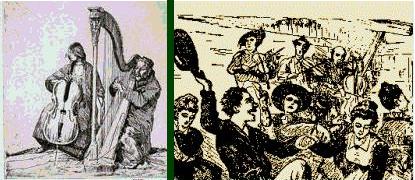This post is copied from my parts of a recent post on Cello Chat, in response to a newbie asking for book recommendations regarding folk music. "Folk music" can mean a lot of things, but I think he probably means fiddle tunes on cello.
Over the past four years of participating on those chat boards I’ve seen quite a few beginners interested in the folkie side of cello come, and then disappear. Off-hand, the only one I can think of that has really stuck with it besides myself is Maricello, who unlike me, is sensible enough to not stick foot-in-mouth there on Cello Chat, as I do [Note: I forgot to mention PFS. Hey, PS, how are you doing on that?].
What Maricello and I have in common is a solid background with another instrument, we take classical-type lessons regularly, practice near daily, keep in touch with and play with the local fiddle/folk instrument community, listen to the folk-type cellists, research and think for ourselves, and realize this is a slow process that will take some years to develop.
I think it’s fair to say, of the usual folk instruments, fiddle is, by far, the hardest. The coordination, ear training, precision, and touch requirements well exceed that required for the fretted instruments, like banjo and guitar. A mandolin or harp, for example, can make nice tones (in tune!) if picked or plucked by a total novice. Not so, the bowed fiddle (and the cello!). Still, a highly motivated and reasonably talented adult, taking fiddle or violin lessons, and practicing daily can be decent enough to play in jams and keep up with a good number of tunes in a year. A violin student that has, for example, completed Suzuki 1 and 2 well, is ready for fiddle tunes.
For cello, make it at least four years (for fiddle tune melodies, that is). I suggest that’s one reason why it’s not a usual folk instrument. Some may dispute it, but for us, typical fiddle tunes are as hard, or harder, than a typical fast movement of a Vivaldi sonata, or a typical student concerto/sonata piece that you’d find in, say, Suzuki 5.
Why? First off, it’s the keys the tunes are usually played in. Virtually all fiddle tunes make full use of the E string (Why? ‘Cause it’s there!). We ain’t got E strings, so we shift --- lots and fast. True, for some tunes we can put it down two octaves, rather than one octave, from the fiddle, but that gives us slower response and often that gets just too slow, thick, and muddy.
Also, it’s the speed. From my own simple-minded approach, there are two basic types of folkie tempos – singing tempos and dancing tempos. For me personally, dancing tempo is where it’s at, but that’s 100-120 beats (foot steps) a minute. For reels and polkas, that’s usually four eighth notes per step. For jigs, we get a break --- only three notes per step, but they also tend to be at the upper range of dance tempos. So we’re looking at 360 to well over 400 notes a minute. It’s going to take quite some time to even be able to perform major scales at that speed, yet alone tunes, yet alone tunes that require constant changes of position, yet alone be anywhere close to in tune.
Why are we so slow? Well, for one thing, the strings are much heavier and much further from the fingerboard, so it takes us longer to finger, and longer for the string to respond. Secondly, our bow arm is not in an optimal position for speed. With their down arms near their side, fiddlers can bow single notes or shuffles very quickly by merely opening and closing their elbows a small bit. With us, we have to either awkwardly hold our arms far out to the side, or move the entire arm from the shoulder for that fast bowing.
Also, without using open strings, a fiddler can play diatonically without shifting. We cannot. We cannot go to, say, 5th position, and just stay there, unless we use the thumb, which is a quite advanced technique.
We have lots of disadvantages, which I think partially explains why there as so few successful professional cellists in the folk world.
But then, we have some advantages too, so if I haven’t scared you off I’ll write about those, maybe tomorrow.


